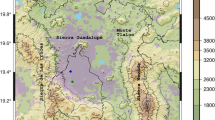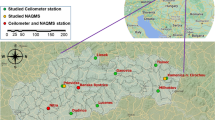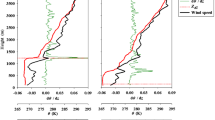Abstract
A comparative study and evaluation of mixing-layer height estimation was conducted, using data from remote sensing and in-situ instrumentation, radiosondes, synoptic analyses and model simulations. The data were collected during an experimental campaign conducted at the Athens International Airport, Greece, from 15 to 26 September 2007. Mixing-layer height from the sodar dataset was estimated taking into account the backscatter signal, temperature, Richardson number profiles and surface-based measurements, while for the ceilometer data, the optical attenuated aerosol backscatter intensity first derivative was utilized. Numerical simulations using the Penn State/NCAR MM5 numerical mesoscale model and the Weather Research and Forecast numerical model were also performed. Comparative results under different meteorological conditions (local flows, moderate to strong background flows) are presented and discussed. According to our results under moderate to strong winds the existing mechanical turbulence creates good signal conditions for the two remote systems leading to a good overall agreement between the two methodologies, while both models give reliable estimations of the mixing height. The sodar-RASS system is more suitable under low to moderate winds or when local flows are developed with weak stability, while the ceilometer system is more suitable for moderate to strong winds, which is associated with a homogeneous atmosphere and weaker low-level temperature inversions. In the models, the existing approach for atmospheric boundary-layer depth simulation usually provides higher compared to remote sensing values, especially during local flow events. An alternative approach for the estimation of mixing height by the models, the estimation and use of the diffusion coefficient profiles, is a promising methodology regarding the comparison with the sodar-RASS mixing-height estimations.
Similar content being viewed by others
References
Akylas E, Tombrou M (2005) Reconsidering and generalized interpolation between Kansas-type formulae and free convection forms. Boundary-Layer Meteorol 115: 381–398
Akylas E, Tsakos Y, Tombrou M, Lalas D (2003) Considerations on minimum friction velocity. Q J R Meteorol Soc 129: 1929–1943
Asimakopoulos DN, Helmis CG, Michopoulos J (2004) Evaluation of SODAR methods for the determination of the atmospheric boundary layer mixing height. Meteorol Atmos Phys 85: 85–92
Athanasopoulou E, Tombrou M, Pandis SN, Russell AG (2008) The role of sea-salt emissions and heterogeneous chemistry in the air quality of polluted coastal areas. Atmos Chem Phys 8: 5755–5769
Baars H, Ansmann A, Engelmann R, Althausen D et al (2008) Continuous monitoring of the boundary-layer top with lidar. Atmos Chem Phys 8: 7281–7296
Beyrich F (1993) On the use of SODAR data to estimate mixing height. Appl Phys B 57: 27–35
Beyrich F (1997) Mixing height estimation from SODAR Data–a critical discussion. Atmos Env 31(23): 3941–3953
Beyrich F, Gorsdorf U (1995) Composing the diurnal cycle of mixing height from simultaneous SODAR and Wind profiler measurements. Boundary-Layer Meteorol 76: 387–394
Boers R, Spinhirne JD, Hart WD (1988) Lidar observations of the fine-scale variability of marine stratocumulus clouds. J Appl Meteorol 27: 797–810
Bossioli E, Tombrou M, Pilinis C (2002) Adapting the speciation of the VOCs emission inventory, in the Greater Athens area. Water Air Soil Pollut Focus 2(5–6): 141–153
Caughey SJ, Wyngaard JC, Kaimal JC (1979) Turbulence in the evolving stable boundary layer. J Atmos Sci 36: 1041–1052
Chang JS, Brost RA, Isaksen ISA, Madronich S, Middleton P, Stockwell WR, Walcek CJ (1987) A three-dimensional Eulerian acid deposition model, physical concepts and formulation. J Geophys Res 92: 14681–14700
Coulter RL (1990) A case study of turbulence in the stable nocturnal boundary layer. Boundary-Layer Meteorol 52: 75–91
Coulter RL, Kallistratova MA (2004) Two decades of progress in SODAR techniques: a review of 11 ISARS proceedings. Meteorol Atmos Phys 85(1–3): 3–20
Cuijpers JWM, Kohsiek W (1989) Vertical profiles of the structure parameter of temperature in the stable, nocturnal boundary layer. Boundary-Layer Meteorol 47: 111–129
Dandou A, Tombrou M, Akylas E, Soulakellis N, Bossioli E (2005) Development and evaluation of an urban parameterization scheme in the Penn State/NCAR Mesoscale Model (MM5). J Geophys Res 110: D10102. doi:10.1029/2004JD005192
Dandou A, Tombrou M, Soulakellis N (2009) The influence of the city of Athens on the evolution of the sea-breeze front. Boundary-Layer Meteorol 131:35–51. doi:10.1007/s10546-008-9306-x
Dudhia J (1989) Numerical study of convection observed during the winter monsoon experiment using a mesoscale two-dimensional model. J Atmos Sci 46:3077–3107. doi:10.1175/1520-0469(1989)046<3077:NSOCOD>2.0.CO;2123
Dudhia J (1996) A multi-layer soil temperature model for MM5. Preprints, the 6th PSU/NCAR Mesoscale Model users, Workshop, Boulder CO, July, National Centre for Atmospheric Research, pp 49–50
Emeis S, Münkel C, Vogt S, Müller WJ, Schäfer K (2004) Atmospheric boundary-layer structure from simultaneous SODAR, RASS, and ceilometer measurements. Atmos Environ 38: 273–286
Emeis S, Jahn C, Münkel C, Münsterer C, Schäfer K (2007) Multiple atmospheric layering and mixing-layer height in the Inn valley observed by remote sensing. Meteorol Z 16: 415–424
Emeis S, Schäfer K, Münkel C (2008) Surface-based remote sensing of the mixing-layer height—a review. Meteorol Z 15(5): 621–630
Emery C, Tai E, Yarwood G (2001) Enhanced meteorological modeling and performance evaluation for two Texas Ozone Episodes, Report to the Texas Natural Resources Conservation Commission, prepared by ENVIRON, International Corp., Novato, CA
Environ (2004) User’s guide to the comprehensive air quality model with extensions (CAMx), version 4.10s, report, ENVIRON Int. Corp., Novato, CA
Eresmaa N, Karppinen A, Joffre SM, Räsänen J, Talvitie H (2006) Mixing height determination by ceilometer. Atmos Chem Phys 6: 1485–1493
Fairall CW (1984) Wind-shear enhancement of entrainment and refractive index structure parameter at the top of the turbulent mixed layer. J Atmos Sci 41: 3472–3484
Flamant C, Pelon J, Flamant PH, Durand P (1997) Lidar determination of the entrainement zone thickness at the top of the unstable marin atmospheric boundary-layer. Boundary-Layer Meteorol 83: 247–284
Garratt JR (1992) The atmospheric boundary layer. Cambridge University Press, UK, 316 pp
Gery MW, Whitten GZ, Killus JP, Dodge MC (1989) A photochemical kinetics mechanism for urban and regional scale computer modeling. J Geophys Res 94: 12925–12956
Grachev AA, Fairall CW, Bradley EF (2000) Convective profile constants revised. Boundary-Layer Meteorol 94: 495–515
Grell GA (1993) Prognostic evaluation of assumptions used by cumulus parameterizations. Mon Wea Rev 121: 764–787
Grell GA, Dudhia J, Stauffer D (1994) A description of the fifth-generation Penn state/NCAR mesoscale model (MM5). NCAR technical note, NCAR/TN-398 +STR, National Centre for Atmospheric Sciences, Boulder, CO, 138 pp
Gryning SE, Batchvarova E (1994) Parametrization of the depth of the entrainment zone above the daytime mixed layer. Q J R Meteorol Soc 120: 47–58
Haeffelin M, Angelini F, Morille Y, Martucci G, Frey S, Gobbi GP, Lolli S, O’Dowd CD, Sauvage L, Xueref-Rémy I, Wastine B, Feist DG (2011) Evaluation of mixing height retrievals from automatic profiling lidars and ceilometers in view of future integrated networks in Europe. Boundary-Layer Meteorol, pp 1–27. doi:10.1007/s10546-011-9643-z
Haij M, Wauben W, Klein Baltink H (2006) Determination of mixing layer height from ceilometer backscatter profiles. In: Slusser JR, Schäfer K, Comerón A (eds) Remote sensing of clouds and the atmosphere XI. Proceedings of the SPIE, vol 6362, paper 63620R, Bellingham, WA
Helmis CG, Papadopoulos KH, Kalogiros J, Soilemes AT, Asimakopoulos DN (1995) The influence of the background flow on the evolution of the Saronic Gulf Sea Breeze. Atmos Environ 29(24): 3689–3701
Helmis CG, Asimakopoulos DN, Papadopoulos KH, Kalogiros JA, Kassomenos P, Papageorgas PG, Blikas S (1997) Air mass exchange between the Athens Basin and the Messogia Plain of Attika, Greece. Atmos Environ 31(22): 3833–3849
Helmis CG, Flocas HA, Kalogiros JA, Asimakopoulos DN (2000) Strong down slope winds and application of hydraulic-like theory. J Geophys Res Clim Phys Atmos 105(D14): 18039–18051
Hong SY, Pan HL (1996) Nonlocal boundary layer vertical diffusion in a medium-range forecast model. Mon Wea Rev 124: 2322–2339
Hong SY, Dudhia J, Chen SH (2004) A revised approach to ice microphysical processes for the bulk parameterization of clouds and precipitation. Mon Wea Rev 132: 103–120
Hong SY, Noh Y, Dudhia J (2006) A new vertical diffusion package with an explicit treatment of entrainment processes. Mon Wea Rev 134: 2318–2341
Hooper WP, Eloranta E (1986) Lidar measurements of wind in the planetary boundary layer: the method, accuracy and results from joint measurements with radiosonde and kytoon. J Clim Appl Meteorol 25: 990–1001
Kain JS, Fritsch JM (1993) Convective parameterization for mesoscale models: The Kain-Fritsch scheme. In Emanuel KA, Raymond DJ (Eds) The representation of cumulus convection in numerical models, Amer Meteor Soc, 246 pp
King JC, Connolley WM, Derbyshire SH (2001) Sensitivity of modeled Antarctic climate to surface and boundary-layer flux parameterizations. Q J R Meteorol Soc 127: 779–794
Martucci G, Matthey R, Mitev V, Richner H (2010) Frequency of boundary-layer-top fluctuations in convective and stable conditions using laser remote sensing. Boundary-Layer Meteorol 135: 313–331
Menut L, Flamant C, Pelon J, Flamant PH (1999) Urban boundary-layer height determination from lidar measurements over the Paris area. Appl Opt 38: 945–954
Morille Y, Haeffelin M, Drobinski P, Pelon J (2007) STRAT: an automated algorithm to retrieve the vertical structure of the atmosphere from single-channel lidar data. J Atmos Ocean Technol 24: 761–775
Münkel C, Roininen R (2010) Automatic monitoring of boundary layer structures and depth with ceilometer using a novel robust algorithm. In: ISARS 2010, international symposium for the advancement of boundary layer remote sensing, Paris, France, extended abstract P_BLS/06. http://www.isars2010.uvsq.fr/images/stories/PosterExtAbstracts/P_BLS06_Muenkel.pdf
Nenes A, Pilinis C, Pandis SN (1998) ISORROPIA a new thermodynamic equilibrium model for multiphase multicomponent marine aerosols. Aquat Geochem 4: 123–152
Parameswaran K (2001) Influence of micrometeorological features on coastal boundary aerosol characteristics at the tropical station, Trivandrum. Proc Indian Acad Sci (Earth Planet Sci) 110: 247–265
Piironen AK, Eloranta EW (1995) Convective boundary layer depths and cloud geometrical properties obtained from volume imaging lidar data. J Geophys Res 100: 25569–25576
Rampanelli G, Zardi D (2004) A method to determine the capping inversion of the convective boundary layer. J Appl Meteorol 43: 925–933
Schäfer K, Emeis S, Rauch A, Münkel C, Vogt S (2004) Determination of mixing-layer heights from ceilometer data. In: Schäfer K, Comeron A, Carleer M, Picard RH, Sifakis N (eds) Remote sensing of clouds and the atmosphere IX, vol 5571. Proc. SPIE, Bellingham, WA, pp 248–259
Schäfer K, Emeis S, Junkermann W, Münkel C (2005) Evaluation of mixing layer height monitoring by ceilometer with SODAR and microlight aircraft measurements. In: Schäfer K, Comeron AT, Slusser JR, Picard RH, Carleer MR, Sifakis N (eds) Remote sensing of clouds and the atmosphere X, vol 5979. Proc. SPIE, Bellingham, WA, 59791I-1-59791I-11
Seibert P, Beyrich F, Gryning SE, Joffre S, Rasmussen A, Tercier P (2000) Review and intercomparison of operational methods for the determination of the mixing height. Atmos Environ 34: 1001–1027
Sgouros G, Helmis CG (2009) Low-level jet development and the interaction of different scale physical processes. Meteorol Atmos Phys 104(3): 213–228
Sgouros G, Helmis CG, Degleris J (2011) Development and application of an algorithm for the estimation of mixing height with the use of a Sodar-RASS system. Int J Remote Sensing 32(22): 7297–7313
Sicard M, Pérez C, Rocadenbosch F, Baldasano JM, García-Vizcaino D (2006) Mixed-layer depth determination in the Barcelona coastal area from regular lidar measurements: methods, results and limitations. Boundary-Layer Meteorol 119: 135–157
Skamarock WC, Klemp JB, Dudhia J, Gill DO, Barker DM, Duda M, Huang XY, WangW, Powers JG (2008) A description of the advanced research WRF, version 3. NCAR Technical Note, 113 pp
Strader R, Gurciullo C, Pandis SN, Kumar N, Lurmann FW (1998) Development of gas-phase chemistry, secondary organic aerosol, and aqueous-phase chemistry modules for PM modelling. Final report for CRC Project A21-1 prepared for the Coordinating Research Council, Atlanta, GA by Sonoma Technology, Inc. Petaluma, CA, STI-97510-1822-FR, October 1998
Stull RB (1988) An introduction to boundary layer meteorology. Atmospheric Sciences Library, Kluwer, Dordrecht, The Netherlands, 666 pp
Tesche TW, McNally DE, Emery CA, Tai E (2001) Evaluation of the MM5 model over the Midwestern U.S. for three 8-hr oxidant episodes. Prepared for the Kansas City Ozone Technical Work Group, prepared by Alpine Geophysics, LLC, Ft. Wright, KY and ENVIRON International Corp., Novato, CA
Tombrou M, Dandou A, Helmis CG, Akylas E, Angelopoulos G, Flocas H, Assimakopoulos V, Soulakellis N (2007) Model evaluation of the atmospheric boundary layer and mixed layer evolution. Boundary-Layer Meteorol 124: 61–79
Troen I, Mahrt L (1986) A simple model for the atmospheric boundary layer: sensitivity to surface evaporation. Boundary-Layer Meteorol 37: 129–148
Wyngaard JC, Lemone MA (1980) Behavior of the refractive index structure parameter in the entraining convective boundary layer. J Atmos Sci 37: 1573–1585
Zhang K, Mao H, Civerolo K, Berman S, Ku YY, Rao ST, Doddridge B, Philbrick CR, Clark R (2001) Numerical investigation of boundary layer evolution and nocturnal low-level jets: local versus non-local ABL schemes. Environ Fluid Mech 1: 171–208
Author information
Authors and Affiliations
Corresponding author
Rights and permissions
About this article
Cite this article
Helmis, C.G., Sgouros, G., Tombrou, M. et al. A Comparative Study and Evaluation of Mixing-Height Estimation Based on Sodar-RASS, Ceilometer Data and Numerical Model Simulations. Boundary-Layer Meteorol 145, 507–526 (2012). https://doi.org/10.1007/s10546-012-9743-4
Received:
Accepted:
Published:
Issue Date:
DOI: https://doi.org/10.1007/s10546-012-9743-4




